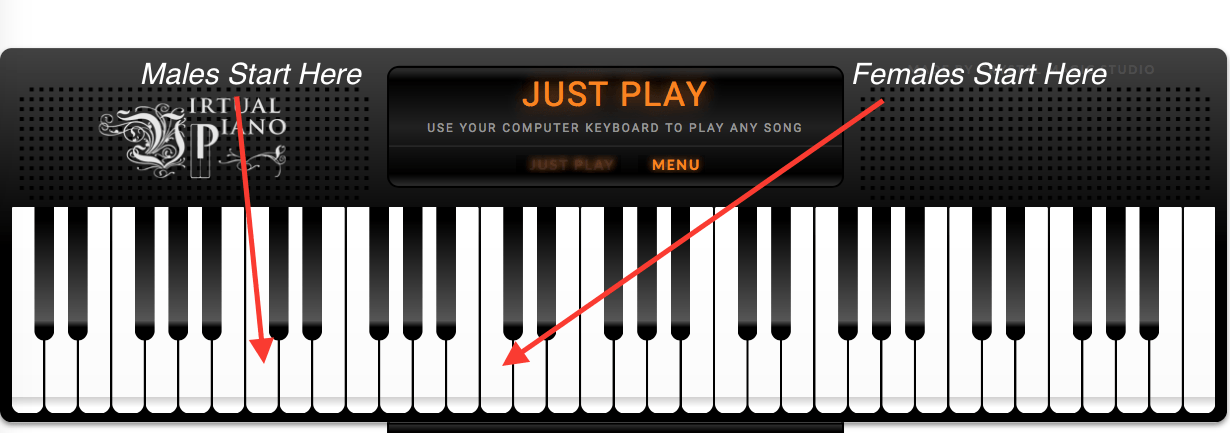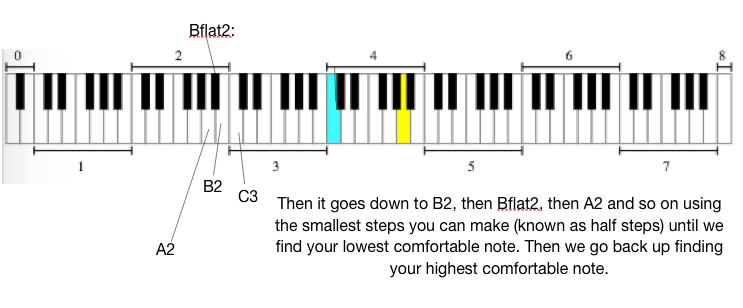How to Find Your Vocal Range on Piano

Hi, I’m Chris, I help beginning singers know exactly where to start & experienced singers find their next vocal breakthrough
Why Most Singers Don't REALLY Know Their Vocal Range, Even When Working with a Teacher... and what to do about it
Most singers don't have a concrete sense of where their voice sits on the piano or sheet music...even if they've worked with a teacher or are working with a teacher, many singers still don't really know where the voice sits or where their most comfortable notes are. So let's get into that!
You, as a beginning or even quite experienced singer, may not know where your range sits on piano even if you've been taking voice lessons, because for voice teachers, we often have to go on quite a detour to take the time to explain where voices sit on the piano, what that looks like for you and a map of the piano showing where your voice sits.
Starting today, I've come up with a simple system to change that in lessons...but I'd love to share that with you, even if you aren't taking lessons with me, because it will enhance your sense of progress in your voice, prepare you for collaborating with others be it a rock band, choir or karaoke among other things. If you are taking voice lessons with a different teacher, this will help you better communicate what is happening in your voice so you can make the most of lessons.First we'll talk about range as I define it, compared to your vocal comfort zone. So let's briefly cover your vocal comfort zone, what it is and how it's different from your vocal range, later in this post we'll go farther into how to use your vocal comfort zone and focus on expanding that, vs. expanding your total range.
Your vocal comfort zone is the bull's eye of your voice: it's where you have the most control, ease, & familiarity. It's where you also have your best sounds (except in rare instances). This is the happy place for your voice and nervous system. This is also where you get away with your worst vocal technique, because your overall coordination is efficient enough to mask the many things you may doing that are, unbeknownst to you, creating limitations in your voice.
Okay now for range as I define it:
I define vocal range a particular way (different from how many teachers teach it) because it's a very practical way to look at your voice without either diminishing it's full potential or being unrealistic about how much you can achieve in what time frame.
The singer also can express the song most easily in their comfort zone. When we are singing, the closer we mimic speech patterns (up to a point) the easier it is for the listener to understand the words of the song and also hear the subtle nuances of vocal and emotional expression. Can you hear sadness, joy, anger in super high whistle tones? eh...kinda/maybe. Have you ever heard singing that almost made you cry? Have a listen again. You may notice that many times it was in the singer's vocal comfort zone or at the edges, not on super high or super low notes they were only just able to reach. If it takes too much concentration just to make the sound in a performance, the attention will be taken away from the MESSAGE of the song and expressing the story/emotion and it will instead go into the technique. In practice, this is good. In performance? Not so much.
So what you want to find in your singing when you first start singing (and actually many times over throughout your life as you sing) is your Vocal Comfort Zone. I'll call this VCZ for short. To map out your VCZ, you'll have several areas to cover:
Your VCZ with pitch range in general
There is usually a group of pitches where you can do the widest variety of sounds in general: this would be your general VCZ when it comes to speech. We can get more granular than that though:
You'll also have a different VCZ when it comes to vowels. Try singing the same note on different vowels, and notice which vowels seem very subtly easier to sing than others. Notice which vowels tend to sound more clear and full, and which vowels sound a little more dull and weak. It's probably hard to tell if you haven't been singing for many years...HOWEVER, bring that same vowel up to higher and higher pitches, or lower and lower, you'll find something changes...that "ee as in 'see'" vowel sound that maybe you could only just barely sense a little more tension in speech, is suddenly very difficult on a higher note! That's because you most likely didn't notice that the way you say the EE vowel sound is already not quite at an efficient place to begin with. It only shows up when you move to your vocal comfort zone edges pitch wise.
Now let's look at volumes.
Sing very loud (comfortably, without any strain) as you can manage technically. You may notice you automatically sing HIGHER. So your vocal comfort zone when it comes to range CHANGES when we change volume. Now what vowel did you sing that on? Because depending on the vowel, that ALSO changes.
So in reality, you have a slightly different VCZ for each vowel, at each volume, at each pitch level, with a particular genre/ tone quality.
More examples:
A loud "EH" as in the word "Set" on a medium high note may be in your VCZ. Change the vowel to an "oo" as in the word "too", and it may no longer be in your VCZ...perhaps it breaks and feel uncomfortable straight away.
So when a singer, unknowingly does exercises that cover 6 octaves, but keeps running into breaks and strain on a song that covers 1.5 octaves, it means they may not actually know their own VCZ very well, despite covering nearly their entire range or more in their vocal exercises.
If you can sing 6 octaves on one vowel at one volume, but struggle with one song that has many different vowels at many different volumes over a narrow range, then it's time for some new exercises and another way to look at your voice. It doesn't mean there was anything wrong with covering a wide range, it just means that a wide range is not the only thing you need to sing well, and it certainly isn't first priority if your goal is to actually sing a song.
This is why I work backwards from the song you want to sing and create exercises that mimic the challenges you run into in the exact song you're singing. If we're not working on a song just yet, then I often use a simple 3 note scale work my way from there. If I'm working with a very skilled soprano Opera singer that wants to dip her toe in the waters of belting, the coordination of singing powerfully and low will be plenty challenging enough on a single note. She does not need a 45-note-albatross-of-an-exercise just yet.
So instead of saying "I want to expand my range", or "find my range", let's say "I want to find where exactly it's most comfortable for me to sing".
Then we can expand your VCZ, which works better for your song, your overall technique, your ability to express, all of it. And you won't end up with a 9 octave range and still struggle through a song because you simply hadn't been led to discover how to better sing a loud "oo" vowel sound...on an easy note.
So how do you find your VCZ when it comes to singing?
You could get a lesson with a teacher, but often times they know your vocal comfort zone, but you still may not have a clear sense of that. In response to this being true for my own teaching, I knew I needed a clear and easy way to show my students how to map their voice on the piano. Particularly if you are just starting lessons, having a concrete, written down chart of where your voice hangs out will be wonderful encouragement and inspiration later when you've seen how far you've come.
Soooo many singers, even after having taken voice lessons, don’t really know where exactly their voice sits on the piano. I realized this teaching voice lessons and worked with my students to come up with a system to know EXACTLY where your voice sits on the piano, without you having to know anything about the piano, reading music, etc. to start with.
Although it’s not hard to find your range on piano in theory, it ends up being super duper confusing because we have multiple systems to categorize notes on the piano. The same exact note can be referred to as C3 OR C4…etc.
So you'll spend 20 minutes just trying to find the one note you're supposed to start on, feel dumb, get frustrated and give up...but it's really not your fault and it can be made easier.
By far the fastest way with the least chance of getting confused is to get the "Find Your Range Kit" that I made for this purpose. It's been tested and verified by students and singers that don't take lessons have tested it out to make sure it's easy to use. You can check that out at the link below, or if you're willing to put some time in and perhaps get confused, you can follow the general steps below.
The Easiest Way to Find Your Range
Piano Chart Worksheets a Video Guide and an MP3 you can sing along with to find your range + common questions answered!
MP3 + PDF Worksheets + Video Guide
Recommended for all beginner singers and most intermediate singers and advanced singers not familiar with where their voice is on piano
Or here's the I-have-five-minutes-to-help-you-out version:
Here's what you'll need:
1. Some sort of real or digital version of a piano:
Choose between these options...(Your best bet that is available to anyone with internet is virtualpiano.net.)
A piano app (I recommend the Perfect Piano App, it labels middle C as C4)
Virtualpiano.net (Middle C is the 3rd C up)
A physical piano

2. Then you need a photo of a piano that you can mark up. You can print a photo out or if you know how to mark up photos that works too. What you'll be doing is putting a little x on the note that you find too low, and the one you find to be too high.

3. Then you'll need to play each note and sing along with each note. This assumes that you can match your voice to a key on the piano.
Then if you're using virtualpiano.net, you'll start on the second C up for males, and the 3rd C up for females...THIS IS ONLY TRUE FOR THIS EXACT PIANO on virtual piano.net...if you go anywhere else the C will be somewhere else and it gets really confusing quickly...hence why I made the guide. So follow the steps exactly. Or the world will end as we know it. Just kidding, 
4. Then you sing each note, going down little by little (like the photo shows) until you get to a note that is too low. Put an X on your printed piano sheet (or mark you digital version somehow). Then sing through again, this time finding your lowest comfortable note. Put a checkmark there. Then do the same thing going higher.

Now what about head voice range, chest voice range, different vowels and volumes? You can map out all of those too, and I have suggestions for doing that in the Find Your Range Kit.
Is the Find Your Range Kit for You?
Let’s Find Out:
The Find Your Range Kit is for you if…
You are not ready for, or don’t need the Find Your Range Kit if…
MP3 + PDF Worksheets + Video Guide
Recommended for all beginner singers and most intermediate singers. Recommended for advanced singers if not familiar with where their voice is on piano